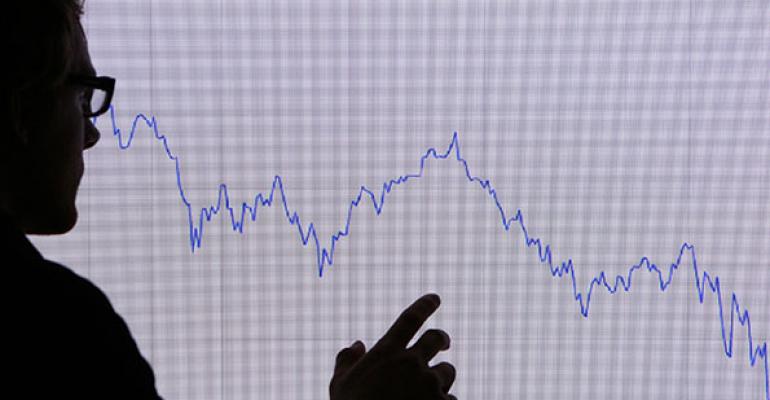(Bloomberg) -- There’s plenty of volatility, but what happened to the volume?
From stocks to currencies and bonds, the upswing in turbulence to start the year is chasing all but the bravest traders from financial markets. Despite the recent rebound in U.S. equities, volume in the S&P 500 Index is down 23 percent. Speculative bets on the direction of currencies have also dropped to the lowest in two years, while average daily trading among dealers in U.S. Treasuries is close to a seven-year low.
Worries about the outlook for the U.S., Europe and China, as well as mixed policy signals from central bankers around the world, have all contributed to what UBS Group AG Chief Executive Officer Sergio Ermotti called a “paralyzing volatility” that’s scaring away clients and caused industry-wide trading revenue to tumble to the lowest since 2009.
Yet in some ways, it also underscores the changing nature of the market itself. Big banks have cut back on trading as post-crisis regulations like Dodd-Frank and Basel III force them to take fewer risks, particularly in fixed-income. Last year alone, Wall Street eliminated more than 20,000 jobs, with trading desks bearing the brunt of the cuts. And while automated traders have swept in to fill the void, some say they’ve made markets more prone to sudden shocks.
Investor concern over the state of the global economy is adding to “the structural pressure that’s been hurting banks for the last few years,” said Paul Gulberg, a banking analyst at Portales Partners LLC.
Whipsawed Traders
Normally, a rise in volatility tends to lead to higher trading activity as traders jump in to bet on the market’s ultimate direction, according to Gulberg. That hasn’t been the case this time. Violent swings across assets have whipsawed just about everyone as concern deepens over the state of the global economy and the effectiveness of negative interest rates and quantitative easing.
At the start of the year, it took just six harrowing weeks for the S&P 500 to lose 11 percent and then a mere five weeks to recoup all the losses. What’s more, it came within months of its August swoon, the first time since 1998 that bull-market investors have suffered two such swings in close succession.
Even after stocks rallied in February, trading has fallen off. U.S. equity volume has averaged 7.2 billion shares a day since the bottom, compared with 9.3 billion shares a day in the first six weeks of the year, data compiled by Bloomberg show. Daily moves in the S&P 500 have also averaged 0.84 percent since August, versus 0.55 percent in the prior two years.
“We’re seeing huge dislocations in markets in this year,” said Atul Lele, the chief investment officer at Deltec International Group. “It isn’t the type of volatility where you see opportunities come out of the woodwork.”
Currencies, Bonds
A similar picture is taking shape in other markets. After putting on a record amount of futures contracts in December, traders have since scaled back wagers on the direction of the dollar against eight major currencies as implied volatility jumped. The last time conviction was so weak in terms of positioning was in 2014.
In Treasuries, long considered the deepest and safest market on the planet, average daily volume among primary dealers fell to $444 billion in April, just above its low in December 2009. That occurred after some measures indicated that swings 10-year Treasury yields soared to record levels, according to TD Securities.
“The state of the world -- it’s fragile at best,” Bob Savage, the CEO of CCTrack Solutions, a New York-based hedge fund.
To a growing number of investors, the fact that markets have become more turbulent and less liquid is a direct and unintended consequence of the structural changes wrought by post-crisis regulations -- which were intended to make banks safer.
Whether it’s because of trading restrictions or capital requirements, they’ve diminished the role of big banks as the market’s primary middleman as risk-taking has become more and more costly.
Hard Hit
Last quarter, trading revenue at the five largest U.S. investment banks fell to a seven-year low. Goldman Sachs Group Inc. reported its worst first-quarter revenue of CEO Lloyd C. Blankfein’s tenure.
Trading in fixed income, currencies and commodities, or FICC, has been particularly hard hit. Globally, the biggest investment banks have seen revenue from FICC sales and trading decline in five of the past six years, according to Bloomberg Intelligence.
Stung by disappointing results, UBS and Credit Suisse Group AG both say they’re focusing their businesses on wealth management rather than trading or making markets.
“The issue around what you call ‘flash crashes’ or ‘gap risk’ is very significantly related to the lack of capital committed by banks to warehousing risk,” said Mark Astley, the CEO of Millennium Global Investments, which oversees about $16 billion. “Banks are just not interested in warehousing risk anymore and obviously bank desks tend to be a lot thinner today.”
--With assistance from Joseph Ciolli, Cecile Vannucci and Rachel Evans. To contact the reporters on this story: Andrea Wong in New York at [email protected] ;Oliver Renick in New York at [email protected] To contact the editors responsible for this story: Boris Korby at [email protected] ;Jeremy Herron at [email protected] Michael Tsang, Chris Nagi





